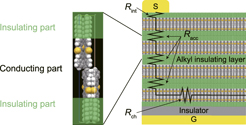Crossref Citations
This article has been cited by the following publications. This list is generated based on data provided by
Crossref.
Arai, Shunto
2020.
Semiconductive Single Molecular Bilayers: a New Platform for High-Performance Organic Transistors.
p.
63.
Sakai, Masatoshi
Liao, Weisong
Okada, Yugo
and
Kudo, Kazuhiro
2020.
Carrier-injection and succeeding pre-channel formation in organic thin-film transistor observed with time-domain reflectometry.
Journal of Applied Physics,
Vol. 128,
Issue. 8,
Hamai, Takamasa
Inoue, Satoru
Arai, Shunto
and
Hasegawa, Tatsuo
2020.
Trap-state suppression and band-like transport in bilayer-type organic semiconductor ultrathin single crystals.
Physical Review Materials,
Vol. 4,
Issue. 7,
Hu, Peng
He, Xuexia
and
Jiang, Hui
2021.
Greater than 10 cm2 V−1 s−1: A breakthrough of organic semiconductors for field‐effect transistors.
InfoMat,
Vol. 3,
Issue. 6,
p.
613.
Takamaru, Shun
Hanna, Jun-ichi
and
Iino, Hiroaki
2021.
Use of doping to achieve low contact resistance in bottom-gate top-contact type organic transistor with liquid-crystalline organic semiconductor, Ph-BTBT-10.
Japanese Journal of Applied Physics,
Vol. 60,
Issue. SB,
p.
SBBG08.
Jena, Sanjoy
and
Ray, Debdutta
2021.
A systematic approach to reduce non idealities in pentacene bottom-contact bottom-gate transistors.
Thin Solid Films,
Vol. 721,
Issue. ,
p.
138542.
Yin, Xiaowen
Yang, Junliang
and
Wang, Haibo
2022.
Vertical Phase Separation Structure for High‐Performance Organic Thin‐Film Transistors: Mechanism, Optimization Strategy, and Large‐Area Fabrication toward Flexible and Stretchable Electronics.
Advanced Functional Materials,
Vol. 32,
Issue. 27,
Li, Bin
Zhang, Yihan
Liu, Yang
Ren, Yiwen
Zhu, Xiaoting
Sun, Lingjie
Zhang, Xiaotao
Yang, Fangxu
Li, Rongjin
and
Hu, Wenping
2022.
Highly Efficient Contact Doping for High-Performance Organic UV-Sensitive Phototransistors.
Crystals,
Vol. 12,
Issue. 5,
p.
651.
He, Zhengran
Zhang, Ziyang
Asare-Yeboah, Kyeiwaa
and
Bi, Sheng
2022.
Solvent Exchange in Controlling Semiconductor Morphology.
Electronic Materials Letters,
Vol. 18,
Issue. 6,
p.
501.
Ghorab, Mahya
Fattah, Ali
and
Joodaki, Mojtaba
2022.
Fundamentals of organic solar cells: A review on mobility issues and measurement methods.
Optik,
Vol. 267,
Issue. ,
p.
169730.
Watanabe, Hiroki
Ushikubo, Sakyo
Sakai, Masatoshi
Kudo, Kazuhiro
and
Masu, Hyuma
2022.
Effective Method for Multi-Probe Electrical Measurements of Organic Single Crystals: Four-Terminal Natural Adhesion Contact.
Solids,
Vol. 3,
Issue. 2,
p.
311.
Sun, Li
Li, Tianyu
Zhou, Jiajian
Li, Wenhao
Wu, Zhongming
Niu, Ruikun
Cheng, Jinxiang
Asare‐Yeboah, Kyeiwaa
and
He, Zhengran
2023.
A Green Binary Solvent Method to Control Organic Semiconductor Crystallization.
ChemistrySelect,
Vol. 8,
Issue. 1,
Yao, Jiarong
Sun, Lingjie
Xiao, Yanling
Liu, Jinyu
Jie, Jiansheng
Liu, Xuying
Yang, Fangxu
Sun, Yajing
Li, Rongjin
and
Hu, Wenping
2023.
Impact of surface free energy on two-dimensional crystallization.
Science China Materials,
Vol. 66,
Issue. 4,
p.
1511.
Mun, Tae Jin
Kim, Jungjun
Seong, Junyoung
Jang, Yerim
Lee, Wonryung
and
Seong, Hyejeong
2024.
Large‐Area Processable Ultrathin Organic Transistors with High Mobility and Mechanical Stabilities.
Advanced Electronic Materials,
Vol. 10,
Issue. 7,
Hasegawa, Tatsuo
Inoue, Satoru
Tsuzuki, Seiji
Horiuchi, Sachio
Matsui, Hiroyuki
Okada, Tomoharu
Kumai, Reiji
Yonekura, Koji
and
Maki-Yonekura, Saori
2024.
Exploration and development of molecule-based printed electronics materials: an integrated approach using experimental, computational, and data sciences.
Science and Technology of Advanced Materials,
Vol. 25,
Issue. 1,
Gicevičius, Mindaugas
Gong, Haoxin
Turetta, Nicholas
Wood, William
Volpi, Martina
Geerts, Yves
Samorì, Paolo
and
Sirringhaus, Henning
2025.
Probing Out‐Of‐Plane Charge Transport in Organic Semiconductors Using Conductive Atomic Force Microscopy.
Advanced Materials,
Vol. 37,
Issue. 7,



